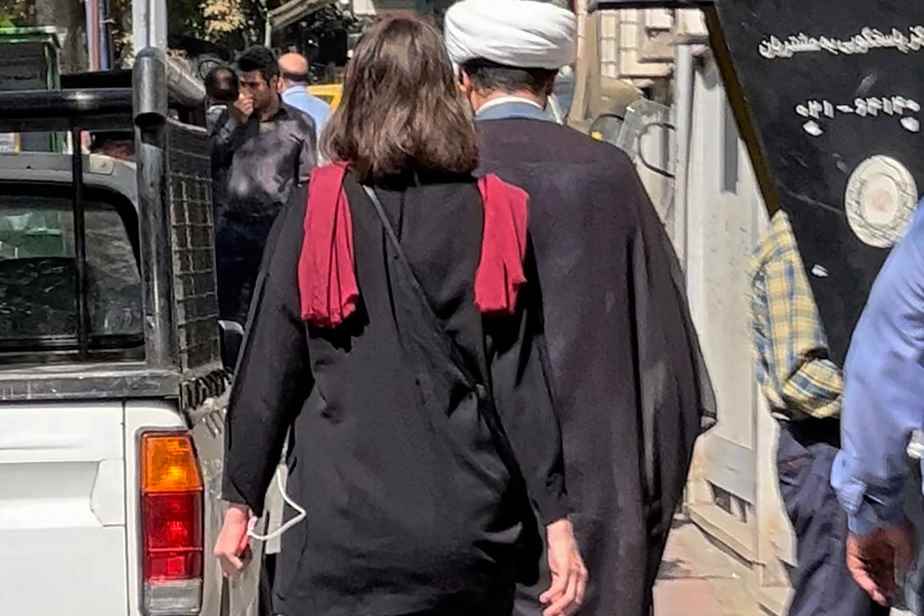Since the death of Mahsa Amini on September 13, 2022, beaten to death for a veil that did not hide all of her hair, Iranian women have been demonstrating in the streets, burning their veils, cutting their hair, risking prison and beatings, even whipping and death.
Posted at 3:00 p.m.
With the support of many men and women of all generations, they dare to challenge a theocratic regime that relied on the symbol of the veil to ensure its power over the population and especially over women.
In 1979, the obligation of the veil was decreed as part of the fundamental laws of Iran.
You have to watch the historical document of the first women’s march of March 8, 19791 to understand the “visceral” opposition of Iranian women to this obligation of the veil decreed by the one who will become shortly after the “supreme guide of the revolution”, the ayatollah Khomeini.
When he has been back from exile for barely a month, we see his eagerness to ban women from going bareheaded. The date of this decree, precisely on the eve of International Women’s Day on March 8, is eloquent as to the symbol that the veil represents for religious fundamentalists, namely a means of putting an end to the aspirations of women’s emancipation. Iranian. Following the threats and violence women suffered that day from many clerics, fear caused it to be the last day women could go bareheaded in Iran.
The hijab as an instrument of female oppression
With the instrumentalization of religion by political Islam, there has been a significant increase in the wearing of the veil by Muslim women all over the world and a strong repression of those who refuse to wear it. These women are imprisoned, assaulted or murdered, even in Quebec or in Canada. Such atrocities demonstrate beyond any doubt that the women’s veil is not just a simple “piece of cloth”, as some well-meaning people persist in believing and claiming: the veil has a meaning that goes beyond this What do those who wear it say?
While the Quran mentions the obligation for women to cover their breasts and not their hair, there is a whole set of pressures to get women to wear a hijab. Beyond the justifications and the identity or religious discourses to justify the wearing of the hijab, we can only note that it is women and not men who have the responsibility of marking the identity of their group or who affirm to wear it to following a process they call “spiritual”.

PHOTO AGENCE FRANCE-PRESSE
Demonstration by arts students at Azad University in Tehran on October 9
Why do they mostly start wearing the veil at puberty, rather than later or earlier in life? A feminist perspective quickly highlights the need to control the fertility of women, which begins at puberty, by prescribing modesty and modesty, even seclusion behind a full veil or confinement at home. Indeed, as women are the only ones able to physically “produce” children, men and society seem to feel the need to regulate this unique ability of women to give birth through control on the sexual, physical and social levels. .
A set of cultural habits are so well integrated from childhood that women no longer even see their restrictive, sexist and discriminatory aspect, the veil being perceived and affirmed as a personal choice.
The physical repression of women through violence, as seen in Iran, is an indicator that other means of controlling women are failing. When women become aware of this control and the inequalities and suffering that this veil entails, there is an incentive to challenge these constraints. Most of the time, it starts on an individual level. Then, when they come together in a collective movement, protest becomes more effective and repression has less hold. Fear can even switch sides. This is what is currently happening to Iranian women: their revolt is shaking the religious power that leads in Iran. This political and judicial power is threatened, despite random extrajudicial arrests and torture.
Since the Islamic revolution in Iran, other countries, such as Saudi Arabia, Afghanistan or those where the terrorist groups of the Islamic State or Al-Qaeda are rife, have followed the model of Iran and have also applied Sharia, this Islamic law which justifies the existence of religious police and brigades with the official aim of “promoting virtue and preventing vice”. It is these morality police who, as a last resort, exert repression allowing the control of women’s bodies.
Stop trivializing or promoting the veil
Will this revolt of Iranian women be able to understand the real issues related to the Islamic veil? Will the people, groups or political parties who trivialize or promote the veil in the name of diversity and inclusion, finally be able to understand that the fight of Iranian women is a fight against the veil and that this veil has the same meaning all over the world: whether women wear it in Iran, Quebec or Canada?
This is why it is so important that signs of the oppression of women are not broadcast in our schools and promoted in our institutions. It is about the freedom of conscience of our children, and especially that of little girls.

